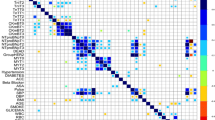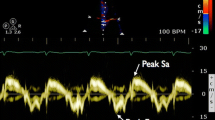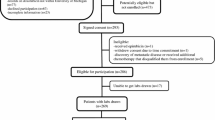Abstract
Anthracyclines are active drugs against breast cancer, but can exert cardiotoxic effects. We analyzed the association between the kinetics of various biomarkers during chemotherapy, and the risk of subsequent cardiac toxicity. 50 patients (49 women) with early breast cancer surgically treated and eligible to anthracycline-based adjuvant chemotherapy were analyzed. The left ventricular ejection fraction (LVEF) together with the plasma concentration of several blood markers was measured at the beginning of anthracycline chemotherapy (t 0), 5 months (t 1), 16 months (t 2), 28 months (t 3), and 40 months later (t 4). A single measured LVEF value less than 50% or a clinically overt congestive heart failure (CHF) was considered cardiotoxic effects. We tested whether the kinetics of LVEF and blood biomarkers measured during chemotherapy was predictive of subsequent cardiotoxicity and overall cardiac fitness. The left ventricular ejection fraction measured at the end of treatment as well as the rate of change of hemoglobin concentration during anthracycline-based chemotherapy predicted cardiotoxicity in a 3-year follow-up period. When LVEF at the end of chemotherapy was lower than 53% or hemoglobin blood concentration declined more than 0.33 g/dL/month during chemotherapy, the odds ratio of subsequent cardiotoxicity was 37.3 and 18, respectively. The specificity of these two tests was 93.3% and 80%, whereas the sensitivity was 90.9 and 81.2%, respectively. Testing the rate of change of hemoglobin concentration during anthracycline-based chemotherapy, as well as the left ventricular ejection fraction at the end of treatment, seems a powerful method to assess the effects of anthracyclines on cardiac fitness and identify patients at high risk of CHF. Further validation of these tests on a large cohort of patients and cost-benefit analysis should be encouraged.



Similar content being viewed by others

References
Early Breast Cancer Trialists’ Collaborative Group (EBCTCG). (2005). Effect of chemotherapy and hormonal therapy for early breast cancer on recurrence and 15-year survival: an overview of the randomised trials. The Lancet, 365, 1687–1717.
Singal, P. K., & Iliskovic, N. (1995). Doxorubicin-induced cardiomyopathy. New England Journal of Medicine, 332, 1738–1743.
Von Hoff, D., Layard, M., Basa, P., Davis, H. L., Von Hoff, H. L., Rozencweig, M., et al. (1979). Risk factors for doxorubicin-induced congestive heart failure. Annals of Internal Medicine, 91, 710–717.
Ryberg, M., Nielsen, D., Skovsgaard, T., Hansen, J., Jensen, B. V., Dombernowsky, P. (1998). Epirubicin cardiotoxicity: An analysis of 469 patients with metastatic breast cancer. Journal of Clinical Oncology, 16, 3502–3508.
Praga, C., Trave, F., & Petroccione, A. (1991). Anthracycline-induced cardiotoxicity and its relevance in cancer treatment. In W. S. Nimmo & G. T. Tucker (Eds.), Clinical measurement in drug evaluation (pp 131–142). Boca Raton, FL: CRC Press.
Ganz, W. I., Sridhar, K. S., Ganz, S. S., Gonzales, R., Chakko, S., Serafini, A. (1996). Review of tests for monitoring doxorubicin-induced cardiomyopathy. Oncology, 53, 461–470.
Mitani, I., Jain, D., Joska, T. M., Burtness, B., Zaret, B. L. (2003). Doxurubicin cardiotoxicity: Prevention of congestive heart failure with serial function monitoring with equilibrium radionuclide angiocardiography in the current era. Journal of Nuclear Cardiology, 10, 132–139.
Feola, M., Garrone, O., Occelli, M., Francini, A., Biggi, A., Visconti, G., et al. (2011). Cardiotoxicity after anthracycline chemotherapy in breast carcinoma: Effects on left ventricular ejection fraction, troponin I and brain natriuretic peptide. International Journal of Cardiology, 148, 194–198.
Corbett, J. R., Akinboboye, O. O., Bacharach, S. L., Borer J. S., Botvinick, E. H., DePuey, E. G., et al. (2006). Equilibrium radionuclide angiocardiography. Journal of Nuclear Cardiology, 13, e56–e79.
De Nigris, F., Rienzo, M., Schiano, C., Fiorito, C., Casamassimi, A., Napoli, C. (2008). Prominent cardioprotective effects of third generation beta blocker nebivolol against anthracycline-induced cardiotoxicity using the model of isolated perfused rat heart. European Journal of Cancer, 44, 334–340.
Kalay, N., Basar, E., Ozdogru, I., Er, O., Cetinkaya, Y., Dogan, A., et al. (2006). Protective effects of carvedilol against anthracycline-induced cardiomyopathy. Journal of the American College of Cardiology, 48, 2258–2262.
Bien, S., Riad, A., Ritter, C. A., Gratz, M., Olshausen, F., Westermann, D., et al. (2007). The endothelin receptor blocker bosentan inhibits doxorubicin-induced cardiomyopathy. Cancer Research, 67, 10428–10435.
Cardinale, D., Colombo, A., Sandri, M. T., Lamantia, G., Colombo, N., Civelli, M., et al. (2006). Prevention of high-dose chemotherapy-induced cardiotoxicity in high-risk patients by angiotensin-converting enzyme inhibition. Circulation, 114, 2474–2481.
Cardinale, D., Colombo, A., Lamantia, G., Colombo, N., Civelli, M., De Gaicomi, G., et al. (2010). Anthracycline-induced cardiomyopathy: Clinical relevance and response to pharmacologic therapy. Journal of the American College of Cardiology, 55, 213–220.
van Dalen, E. C., Caron, H. N., Dickinson, H. O., & Kremer, L. C. (2008). Cardioprotective interventions for cancer patients receiving anthracyclines. Cochrane Database of Systematic Reviews (2), CD003917.
Lipshultz, S. E., Rifai, N., Sallan, S. E., Lipsitz, S. R., Dalton, V., Sacks, D. B., & Ottlinger, M. E. (1997). Predictive value of cardiac troponin T in pediatric patients at risk for myocardial injury. Circulation, 96, 2641–2648.
Cardinale, D., Sandri, M. T., Martinoni, A., Borghini, E., Civelli, M., Lamantia, G., et al. (2002). Myocardial injury revealed by plasma troponin I in breast cancer treated with high-dose chemotherapy. Annals of Oncology, 13, 710–715.
Cardinale, D., Sandri, M. T., Colombo, A., Colombo, N., Boeri, M., Lamantia, G., et al. (2004). Prognostic value of troponin I in cardiac risk stratification of cancer patients undergoing high-dose chemotherapy. Circulation, 109, 2749–2754.
Shinohara, K., & Tanaka, K. R. (1980). The effects of adriamycin (doxorubicin HCl) on human red blood cells. Hemoglobin, 4, 735–745.
Misiti, F., Giardina, B., Mordente, A., & Clementi, M. E. (2003). The secondary alcohol and aglycone metabolites of doxorubicin alter metabolism of human erythrocytes. Brazilian Journal of Medical and Biological Research, 36, 1643–1651.
Catena, C., Colussi, G., Marzano, L., & Sechi, L. A. (2011). Aldosterone and the heart: From basic research to clinical evidence. Hormone and Metabolic Research [Epub ahead of print].
Suzuki, T., Hayashi, D., Yamazaki, T., et al. (1998). Elevated B-type natriuretic peptide levels after anthracycline administration. American Heart Journal, 136, 362–363.
Cheitlin, M. D., Armstrong, W. F., Aurigemma, G. P., Beller, G. A., Biermon, F. Z., Davis, J. l., et al. (2003). ACC/AHA/ASE 2003 guideline update for the clinical application of echocardiography: Summary article: a report of the American College of Cardiology/American Heart Association Task Force on Practice Guidelines. Journal of the American College of Cardiology, 42, 954–970.
Author information
Authors and Affiliations
Corresponding author
Electronic supplementary material
Below is the link to the electronic supplementary material.
12012_2011_9149_MOESM1_ESM.tif
Supplementary figure 1: representative kinetic profiles of LVEF for 3 out of the 41 cases in which LVEF was measured at each time point during follow-up. Red lines indicate the 50% cut-off LVEF value. (TIFF 111 kb)
12012_2011_9149_MOESM2_ESM.tif
Supplementary figure 2: average kinetic profiles of several blood biomarkers. P-values summarize the results of unpaired t tests comparing the distributions indicated by horizontal square brackets. WBC: white blood cells count. (TIFF 182 kb)
Rights and permissions
About this article
Cite this article
Garrone, O., Crosetto, N., Lo Nigro, C. et al. Prediction of Anthracycline Cardiotoxicity after Chemotherapy by Biomarkers Kinetic Analysis. Cardiovasc Toxicol 12, 135–142 (2012). https://doi.org/10.1007/s12012-011-9149-4
Published:
Issue Date:
DOI: https://doi.org/10.1007/s12012-011-9149-4



